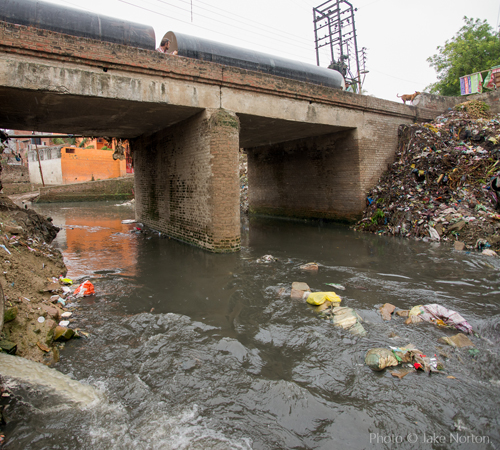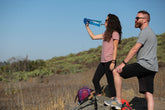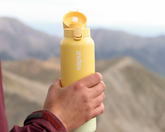Written by Vapur Pro Team member, Jake Norton.After almost 30 trips to the Indian subcontinent over the years, I’ve developed a good tolerance for the local gut flora and fauna. I rarely get sick anymore, and am fairly adventurous with my intake, eating street foods and enjoying local drinks. But, my rule of thumb – backed up by simple visual investigations – is to never drink the water.“Don’t drink the water.” I was reminded of this saying as I filled my Vapur MicroFilter bottle from the tap in Agra. Those four words have become a trite sendoff for people traveling to the world’s lesser developed spots, an off the cuff warning that the destination doesn’t have the basic facilities we in the West have come to take for granted. For 764 million people globally, “don’t drink the water” is exactly what they wish they could do… but have no choice, for they lack access to safe water in their daily lives.Such was the case for me and my teammates - Pete McBride and David Morton – as we traveled the length of the Ganges River for six weeks this autumn. Our expedition – generously funded by Microsoft Surface, Eddie Bauer, National Geographic, and Ambuja Cement, and supported by Vapur – was solely focused on telling the story of this most iconic, most revered, and often most reviled of rivers. From the very top of the Gangotri Glacier at the river’s source, we studied the river, conducted in-depth ecology tests of its waters, met with experts trying to save this troubled artery, spoke with the devout who revere her waters as the mother of all water, and saw firsthand its beauty and its challenges for 1500 miles all the way to the Bay of Bengal.And, we were reminded daily of exactly why we didn’t want to drink the water. Chromium. Lead. Arsenic. Petroleum. Raw sewage. We saw those things, and much more, going into the Ganges nearly from start to finish. An estimated 1 billion liters of untreated sewage enters the river daily from the nearly 400 million people who live along its banks. In the delta on the Bay of Bengal, tens of thousands suffer from arsenic poisoning, resulting in skin lesions and damage to internal organs. The tanneries of Kanpur dump a slurry of chromium and other chemicals into the river, most of it unchecked by the government water treatments facilities. But, yet, people drink. They bathe. They live on and around and in this holiest of rivers, tapping its nourishing waters for all facets of daily life. And, many get sick. Many suffer a life of disease thanks to the pollution, or a life of servitude trying to bring water to their homes and villages and then treat it before consumption. Having seen it firsthand, and documented the river’s beauty and challenges, the spots where it’s pristine and those where it’s horrifically polluted, we’re now working on bringing the story and the river to life in film and photograph and the written word. We hope that this story can help awaken many to the plight of the river…and all those who depend on it.As for the water? Thanks to the MicroFilter, I drank it and drank it, fresh from the source, for 1500 miles – source to sea. And I was one of the lucky ones and had the means to clean my water and not get sick.
But, yet, people drink. They bathe. They live on and around and in this holiest of rivers, tapping its nourishing waters for all facets of daily life. And, many get sick. Many suffer a life of disease thanks to the pollution, or a life of servitude trying to bring water to their homes and villages and then treat it before consumption. Having seen it firsthand, and documented the river’s beauty and challenges, the spots where it’s pristine and those where it’s horrifically polluted, we’re now working on bringing the story and the river to life in film and photograph and the written word. We hope that this story can help awaken many to the plight of the river…and all those who depend on it.As for the water? Thanks to the MicroFilter, I drank it and drank it, fresh from the source, for 1500 miles – source to sea. And I was one of the lucky ones and had the means to clean my water and not get sick.
 But, yet, people drink. They bathe. They live on and around and in this holiest of rivers, tapping its nourishing waters for all facets of daily life. And, many get sick. Many suffer a life of disease thanks to the pollution, or a life of servitude trying to bring water to their homes and villages and then treat it before consumption. Having seen it firsthand, and documented the river’s beauty and challenges, the spots where it’s pristine and those where it’s horrifically polluted, we’re now working on bringing the story and the river to life in film and photograph and the written word. We hope that this story can help awaken many to the plight of the river…and all those who depend on it.As for the water? Thanks to the MicroFilter, I drank it and drank it, fresh from the source, for 1500 miles – source to sea. And I was one of the lucky ones and had the means to clean my water and not get sick.
But, yet, people drink. They bathe. They live on and around and in this holiest of rivers, tapping its nourishing waters for all facets of daily life. And, many get sick. Many suffer a life of disease thanks to the pollution, or a life of servitude trying to bring water to their homes and villages and then treat it before consumption. Having seen it firsthand, and documented the river’s beauty and challenges, the spots where it’s pristine and those where it’s horrifically polluted, we’re now working on bringing the story and the river to life in film and photograph and the written word. We hope that this story can help awaken many to the plight of the river…and all those who depend on it.As for the water? Thanks to the MicroFilter, I drank it and drank it, fresh from the source, for 1500 miles – source to sea. And I was one of the lucky ones and had the means to clean my water and not get sick.



